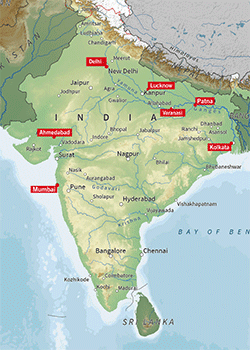Showcase exhibition „Chapakhana – neue Technik, neue Märkte, neues Publikum. Eine kurze Geschichte des Buchdrucks in Nordindien, 1800–1930“
Showcase exhibition on the ground floor of the university library
16 October 2019 to mid-September 2020

- (Map section: Mapwire, CC BY 4.0)
The CATS library presents a short history of book printing in northern India (1800-1930) in a total of four showcases in the entrance area of Heidelberg University Library (UB Heidelberg) with exhibits from its holdings and the holdings of the UB Heidelberg. The exhibition can be visited from 16 October 2019 to 30 June 2020 during the UB's opening hours.
The history of book printing on the Indian subcontinent can be traced back to the 8th century, when books were already produced in the Himalayan region using the block printing process. The first printing press with movable type was set up by Jesuit missionaries in 1556 in Goa. In the following centuries, missionaries in particular proved to be pioneers of printing by using the new technology to spread the Christian message. Geographically, book printing was initially limited to the coastal regions and southern India. In the late 18th century letterpress printing also reached eastern India. The trade and administrative metropolis of Kolkata quickly developed into a centre of book production. The growing need for teaching material for the training of civil servants in the emerging colonial state contributed to the spread, as did the activities of missionaries who produced printing types for Indian regional languages and standardised fonts.
While printing presses with Indian owners were rare in the early years, the advent of lithography in the 1820s marked a turning point. Lithography developed into the preferred printing technique and promoted above all letterpress printing in the regional languages. The acquisition costs for this printing technique were low, which led to numerous new printing companies being founded by Indian (small) entrepreneurs. For example, about 120 printing works had been proven for Lucknow and about 30 for Varanasi. New work and earning opportunities arose for writers and calligraphers. Parallel to this, a local paper industry developed and contributed to the boom in book production.
Technical innovation combined with the emergence of a new reading public led to the commercialisation of book printing from the second half of the 19th century onwards. Print runs increased, many titles appeared in several editions, and new genres emerged in entertainment literature, such as novels and edifying literature. Book printing had become a strong cultural and political force.
Conception and accompanying texts:
Nicole Merkel-Hilf
 E-Mail
E-Mail
Elizaveta Ilves
E-Mail
Dorothee Becker
E-Mail
CATS Bibliothek / Abt. Südasien
Voßstrasse 2, Gebäude 4110
D-69115 Heidelberg




